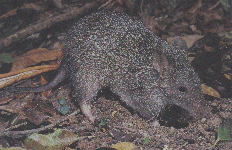 Photo: C & D Frith
Photo: C & D Frith
Australia's Cape York
Peninsula |
Northern Brown Bandicoot: Isoodon macrourus
It is a carnivorous marsupial with a reverse pouch, so that will not fill
with soil when digging.
Speckled brown-black coat covers its back, with its underside light in colour.
Short-sighted.
|
Habitat:
- Common in the rainforest
- Found in areas of low ground cover, including tall grass and dense shrubbery.
- Days are spent in a well concealed nest which has a heap of ground litter
covering a shallow dip, hence providing an underground enclosure with loose regions at
each end for entry and exit.
- In times of rain, the nest is water proofed by kicking a layer of soil over the
top, or the bandicoot may choose to rest in hollow logs or tussocks.
Diet:
- Food is found at night time over a sparse range of land. The animal prefers to
eat insects and other invertebrates such as spiders and earthworms, but it is omnivorous,
thus, able to eat plant materials.
- Food obtained from the rainforest floor, rotted logs or by digging underground
with their forepaws.
Social Behaviour:
- Males are larger than females, have larger canine teeth, are more aggressive and
have larger feeding ranges
- Males have a gland behind their ear which marks their area during fights and
courting
- Males and females only come together during the mating season.
Viewing opportunities:
- Will often be seen after dark at Chambers Wildlife Rainforest Lodge digging in
the rainforest floor.
- Commonly seen on Lake Eacham roadway illuminated by the car headlights.
|
|
